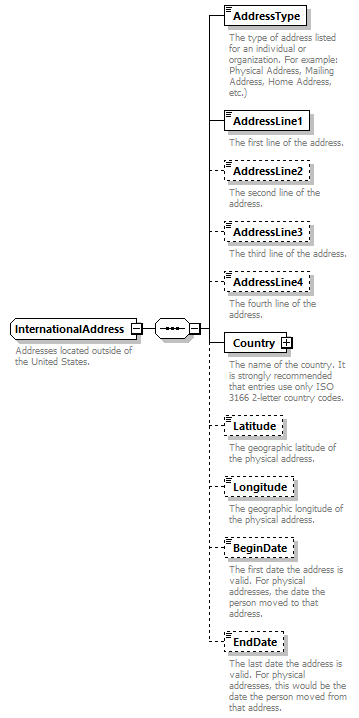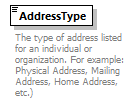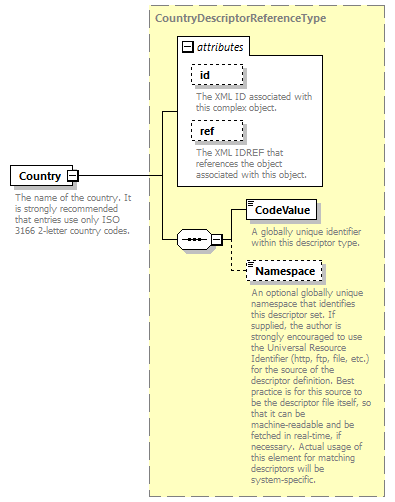complexType
InternationalAddress
element InternationalAddress/AddressType
element InternationalAddress/AddressLine1
element InternationalAddress/AddressLine2
element InternationalAddress/AddressLine3
element InternationalAddress/AddressLine4
element InternationalAddress/Country
element InternationalAddress/Latitude
element InternationalAddress/Longitude
element InternationalAddress/BeginDate
element InternationalAddress/EndDate
| diagram |  |
||||
| namespace | http://ed-fi.org/0210 | ||||
| children | AddressType AddressLine1 AddressLine2 AddressLine3 AddressLine4 Country Latitude Longitude BeginDate EndDate | ||||
| used by |
|
||||
| annotation |
|
||||
| source | <xs:complexType name="InternationalAddress"> <xs:annotation> <xs:documentation>Addresses located outside of the United States.</xs:documentation> <xs:appinfo> <ann:TypeGroup>Common</ann:TypeGroup> </xs:appinfo> </xs:annotation> <xs:sequence> <xs:element name="AddressType" type="AddressType"> <xs:annotation> <xs:documentation>The type of address listed for an individual or organization. For example: Physical Address, Mailing Address, Home Address, etc.)</xs:documentation> </xs:annotation> </xs:element> <xs:element name="AddressLine1" type="AddressLine"> <xs:annotation> <xs:documentation>The first line of the address.</xs:documentation> </xs:annotation> </xs:element> <xs:element name="AddressLine2" type="AddressLine" minOccurs="0"> <xs:annotation> <xs:documentation>The second line of the address.</xs:documentation> </xs:annotation> </xs:element> <xs:element name="AddressLine3" type="AddressLine" minOccurs="0"> <xs:annotation> <xs:documentation>The third line of the address.</xs:documentation> </xs:annotation> </xs:element> <xs:element name="AddressLine4" type="AddressLine" minOccurs="0"> <xs:annotation> <xs:documentation>The fourth line of the address.</xs:documentation> </xs:annotation> </xs:element> <xs:element name="Country" type="CountryDescriptorReferenceType"> <xs:annotation> <xs:documentation>The name of the country. It is strongly recommended that entries use only ISO 3166 2-letter country codes.</xs:documentation> <xs:appinfo> <ann:Descriptor>CountryDescriptor</ann:Descriptor> </xs:appinfo> </xs:annotation> </xs:element> <xs:element name="Latitude" type="Coordinate" minOccurs="0"> <xs:annotation> <xs:documentation>The geographic latitude of the physical address.</xs:documentation> </xs:annotation> </xs:element> <xs:element name="Longitude" type="Coordinate" minOccurs="0"> <xs:annotation> <xs:documentation>The geographic longitude of the physical address.</xs:documentation> </xs:annotation> </xs:element> <xs:element name="BeginDate" type="xs:date" minOccurs="0"> <xs:annotation> <xs:documentation>The first date the address is valid. For physical addresses, the date the person moved to that address.</xs:documentation> </xs:annotation> </xs:element> <xs:element name="EndDate" type="xs:date" minOccurs="0"> <xs:annotation> <xs:documentation>The last date the address is valid. For physical addresses, this would be the date the person moved from that address.</xs:documentation> </xs:annotation> </xs:element> </xs:sequence> </xs:complexType> |
element InternationalAddress/AddressType
| diagram |  |
||||||||||||||||||||||||||||||||||||||||||||||||
| namespace | http://ed-fi.org/0210 | ||||||||||||||||||||||||||||||||||||||||||||||||
| type | AddressType | ||||||||||||||||||||||||||||||||||||||||||||||||
| properties |
|
||||||||||||||||||||||||||||||||||||||||||||||||
| facets |
|
||||||||||||||||||||||||||||||||||||||||||||||||
| annotation |
|
||||||||||||||||||||||||||||||||||||||||||||||||
| source | <xs:element name="AddressType" type="AddressType"> <xs:annotation> <xs:documentation>The type of address listed for an individual or organization. For example: Physical Address, Mailing Address, Home Address, etc.)</xs:documentation> </xs:annotation> </xs:element> |
element InternationalAddress/AddressLine1
| diagram |  |
|||||||||
| namespace | http://ed-fi.org/0210 | |||||||||
| type | AddressLine | |||||||||
| properties |
|
|||||||||
| facets |
|
|||||||||
| annotation |
|
|||||||||
| source | <xs:element name="AddressLine1" type="AddressLine"> <xs:annotation> <xs:documentation>The first line of the address.</xs:documentation> </xs:annotation> </xs:element> |
element InternationalAddress/AddressLine2
| diagram |  |
|||||||||
| namespace | http://ed-fi.org/0210 | |||||||||
| type | AddressLine | |||||||||
| properties |
|
|||||||||
| facets |
|
|||||||||
| annotation |
|
|||||||||
| source | <xs:element name="AddressLine2" type="AddressLine" minOccurs="0"> <xs:annotation> <xs:documentation>The second line of the address.</xs:documentation> </xs:annotation> </xs:element> |
element InternationalAddress/AddressLine3
| diagram |  |
|||||||||
| namespace | http://ed-fi.org/0210 | |||||||||
| type | AddressLine | |||||||||
| properties |
|
|||||||||
| facets |
|
|||||||||
| annotation |
|
|||||||||
| source | <xs:element name="AddressLine3" type="AddressLine" minOccurs="0"> <xs:annotation> <xs:documentation>The third line of the address.</xs:documentation> </xs:annotation> </xs:element> |
element InternationalAddress/AddressLine4
| diagram |  |
|||||||||
| namespace | http://ed-fi.org/0210 | |||||||||
| type | AddressLine | |||||||||
| properties |
|
|||||||||
| facets |
|
|||||||||
| annotation |
|
|||||||||
| source | <xs:element name="AddressLine4" type="AddressLine" minOccurs="0"> <xs:annotation> <xs:documentation>The fourth line of the address.</xs:documentation> </xs:annotation> </xs:element> |
element InternationalAddress/Country
| diagram |  |
||||||||||||||||||||||
| namespace | http://ed-fi.org/0210 | ||||||||||||||||||||||
| type | CountryDescriptorReferenceType | ||||||||||||||||||||||
| properties |
|
||||||||||||||||||||||
| children | CodeValue Namespace | ||||||||||||||||||||||
| attributes |
|
||||||||||||||||||||||
| annotation |
|
||||||||||||||||||||||
| source | <xs:element name="Country" type="CountryDescriptorReferenceType"> <xs:annotation> <xs:documentation>The name of the country. It is strongly recommended that entries use only ISO 3166 2-letter country codes.</xs:documentation> <xs:appinfo> <ann:Descriptor>CountryDescriptor</ann:Descriptor> </xs:appinfo> </xs:annotation> </xs:element> |
element InternationalAddress/Latitude
| diagram |  |
|||||||||
| namespace | http://ed-fi.org/0210 | |||||||||
| type | Coordinate | |||||||||
| properties |
|
|||||||||
| facets |
|
|||||||||
| annotation |
|
|||||||||
| source | <xs:element name="Latitude" type="Coordinate" minOccurs="0"> <xs:annotation> <xs:documentation>The geographic latitude of the physical address.</xs:documentation> </xs:annotation> </xs:element> |
element InternationalAddress/Longitude
| diagram |  |
|||||||||
| namespace | http://ed-fi.org/0210 | |||||||||
| type | Coordinate | |||||||||
| properties |
|
|||||||||
| facets |
|
|||||||||
| annotation |
|
|||||||||
| source | <xs:element name="Longitude" type="Coordinate" minOccurs="0"> <xs:annotation> <xs:documentation>The geographic longitude of the physical address.</xs:documentation> </xs:annotation> </xs:element> |
element InternationalAddress/BeginDate
| diagram |  |
||||||
| namespace | http://ed-fi.org/0210 | ||||||
| type | xs:date | ||||||
| properties |
|
||||||
| annotation |
|
||||||
| source | <xs:element name="BeginDate" type="xs:date" minOccurs="0"> <xs:annotation> <xs:documentation>The first date the address is valid. For physical addresses, the date the person moved to that address.</xs:documentation> </xs:annotation> </xs:element> |
element InternationalAddress/EndDate
| diagram |  |
||||||
| namespace | http://ed-fi.org/0210 | ||||||
| type | xs:date | ||||||
| properties |
|
||||||
| annotation |
|
||||||
| source | <xs:element name="EndDate" type="xs:date" minOccurs="0"> <xs:annotation> <xs:documentation>The last date the address is valid. For physical addresses, this would be the date the person moved from that address.</xs:documentation> </xs:annotation> </xs:element> |